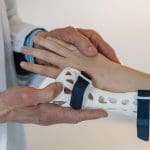
As 2024 winds down, anticipation is building for the strides orthopedics is expected to make in the coming year. For surgeons and practices, staying ahead of these advancements is not just about improving patient care—it’s about seizing new opportunities to grow and thrive. From groundbreaking technologies like AI-assisted diagnostics to innovative surgical tools, the developments on the horizon promise to reshape how orthopedic care is delivered. Let’s explore some of the most influential innovations set to make an impact in the year ahead.
Smart Implants Revolutionizing Joint Surgery
Smart implant technology has been quietly transforming joint replacement procedures, and 2025 is expected to see a significant leap forward. These implants, embedded with sensors, are capable of delivering real-time data about joint functionality, alignment, and healing progress. With this data, surgeons can closely monitor recovery and make evidence-based adjustments as needed.
For example, sensor-enabled knee implants can track range of motion and pressure distribution, helping patients and surgeons address potential issues without invasive interventions. These advancements not only promise improved surgical outcomes but also open the door for practices to set themselves apart with cutting-edge offerings.
Artificial Intelligence in Diagnostics and Surgical Planning
The integration of artificial intelligence (AI) into orthopedics continues to gain traction, and 2025 will see further refinement in how AI assists with diagnostics and surgical planning. AI algorithms can analyze imaging data with remarkable precision, identifying patterns that even the most experienced specialists might overlook. This capability allows for early detection of conditions like osteoarthritis or bone fractures, enabling timely intervention.
Beyond diagnostics, AI-driven platforms are transforming surgical planning. Solutions now use AI to create personalized 3D models of a patient’s anatomy, allowing surgeons to simulate procedures before entering the operating room. This enhances precision, shortens surgical times, and reduces risks. Practices adopting AI tools stand to improve patient satisfaction while boosting efficiency.
Advanced Biomaterials Enhancing Implant Longevity
The longevity of orthopedic implants has always been a critical focus area, and 2025 will usher in new biomaterials designed to last longer and reduce complications. Drug-eluting polymers, for instance, can release antimicrobial agents over time, significantly decreasing the risk of infection. Other innovations include materials engineered to mimic natural bone properties, improving osseointegration and reducing wear and tear.
These advancements have the potential to elevate the quality of life for patients undergoing joint replacements, as well as reduce long-term costs for practices. Adopting these materials could also enhance a practice’s reputation for offering state-of-the-art care.
Robotics Advancing Precision in Surgery
Robotic-assisted surgery has been one of the most significant orthopedic breakthroughs in recent years, and the technology only continues to evolve. By 2025, enhanced robotics systems will allow for even greater precision in procedures such as hip replacements and ligament repairs. These systems integrate imaging data in real time, enabling adjustments during surgery that lead to optimal outcomes.
As you know, the benefits of robotic surgery include smaller incisions, less blood loss, and faster recovery times for patients. For orthopedic practices, investing in robotics can attract patients who are seeking advanced options and propel the practice’s reputation as a leader in innovation.
Regenerative Medicine Offering Nonsurgical Solutions
The rise of regenerative medicine has provided orthopedic surgeons with promising nonsurgical treatment options. Techniques like platelet-rich plasma (PRP) therapy and stem cell injections are offering alternatives for conditions such as tendon injuries, arthritis, and sports injuries. By utilizing the patient’s own biological material, these treatments stimulate healing and repair, reducing reliance on invasive procedures.
Emerging innovations in regenerative medicine, such as synthetic scaffolds for cartilage regeneration, are expected to further expand the boundaries of what’s possible. Patients value these less invasive solutions, and practices incorporating them into their offerings can meet the increasing demand for personalized care.
Digital Solutions Optimizing Practice Operations
While much of the innovation in orthopedics occurs in the operating room or clinic, advancements in digital solutions are also transforming how practices operate. Patient engagement platforms, for example, allow practices to provide personalized communication, track patient progress, and simplify scheduling. Data analytics tools are also enabling practices to streamline workflows, identify bottlenecks, and enhance efficiency.
By adopting these tools, orthopedic practices can improve the patient experience and optimize their growth trajectory simultaneously.
Partnering to Advance Innovation
The opportunities for orthopedic practices in 2025 are extraordinary, but navigating them requires thoughtful strategy, resources, and collaboration. At AOP, we pride ourselves on being a physician-led organization that empowers other physician-led practices to succeed. Private equity might feel like a leap for some, but with the right partner, it becomes a pathway to innovation, growth, and clinical excellence.
Looking ahead, the innovations taking shape in orthopedic surgery and practice management are more than just technological advancements—they’re opportunities. Opportunities to enhance patient outcomes. Opportunities to grow. And opportunities to thrive in an exciting future for orthopedics.
—————————————–
References:













Sorry, the comment form is closed at this time.